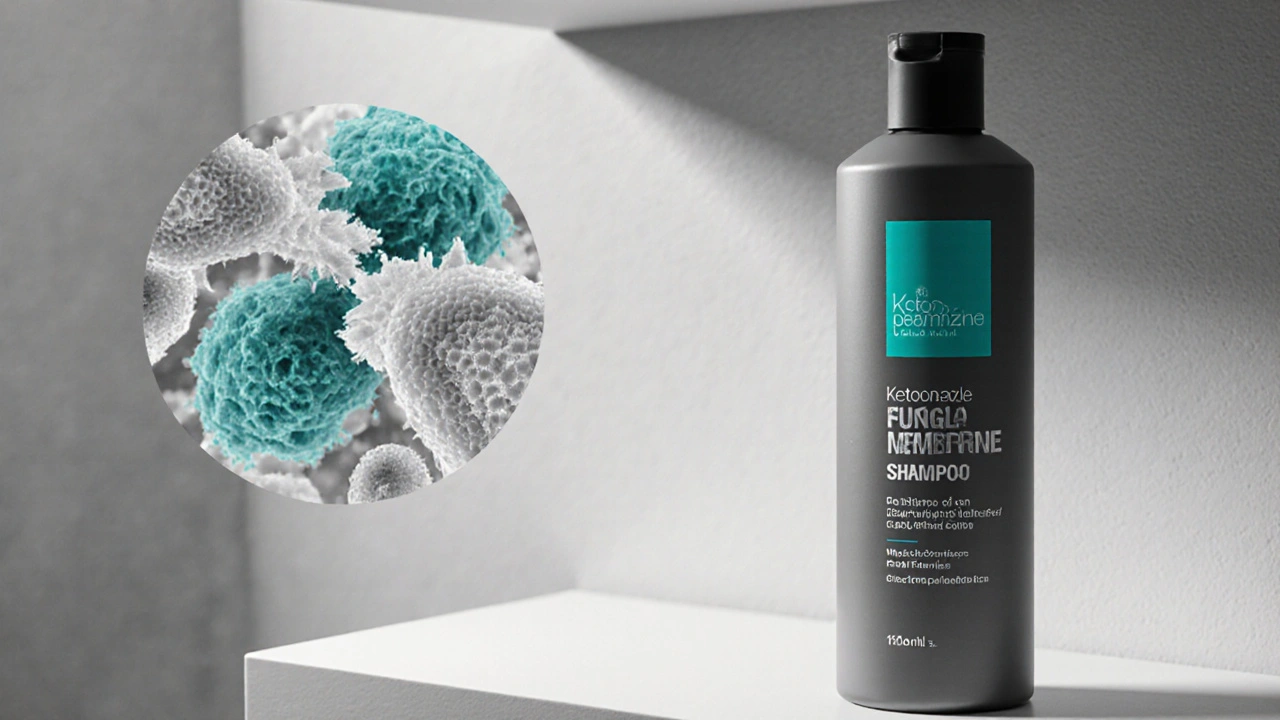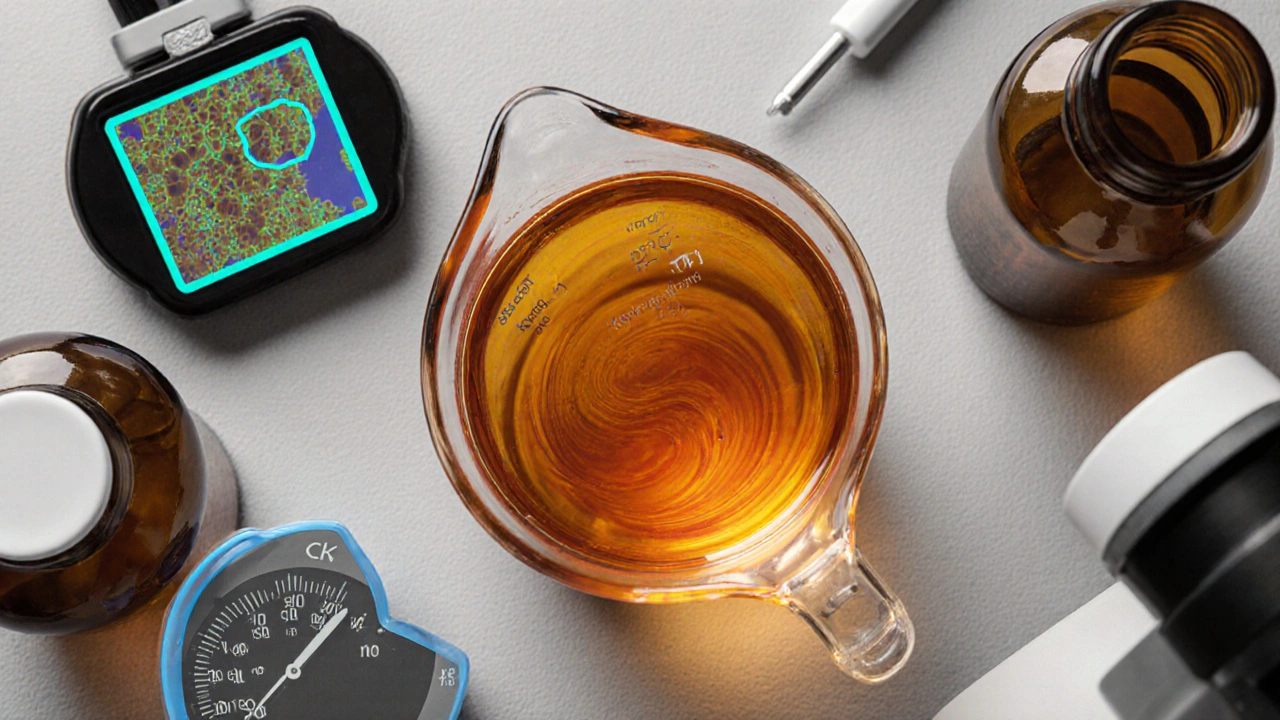Ketoconazole in Cosmetics: Benefits, Risks, and Safe Use

Ketoconazole Concentration & Regulatory Checker
Regulatory Safety Guide
This tool helps you understand safe ketoconazole concentrations for cosmetic products based on regional regulations and product type. Remember: 0.5-2% is typical for rinse-off products, but leave-on products have stricter limits.
Regulatory Limits
When you see ketoconazole is a synthetic antifungal compound that works by disrupting fungal cell membranes, you probably think of prescription shampoos for dandruff. But the same ingredient is now popping up in a growing number of skin‑care and hair‑care products. ketoconazole in cosmetics promises clearer scalp, fewer breakouts, and a boost in product stability - yet it also raises safety questions that consumers and formulators alike need to answer.
Key Takeaways
- Ketoconazole is an effective antifungal that can treat dandruff, seborrheic dermatitis, and mild acne when used correctly.
- Typical cosmetic concentrations (0.5‑2%) are far lower than prescription levels, reducing systemic exposure.
- Potential risks include skin irritation, allergic reactions, and hormonal effects at high doses.
- Regulatory bodies (FDA, EU) allow limited use in rinse‑off products but restrict leave‑on applications.
- Consumers should look for clear labeling, patch‑test new products, and consult a dermatologist if irritation occurs.
How Ketoconazole Works: The Science in Simple Terms
Ketoconazole belongs to the antifungal agent family. Its main trick is to block an enzyme called lanosterol14α‑demethylase, which fungi need to produce ergosterol - the building block of their cell walls. Without ergosterol, the fungal membrane becomes leaky and the organism dies.
In cosmetics, the antifungal action translates to reduced yeast overgrowth on the scalp and skin. The most common culprit is Malassezia species, which thrive in oily environments and feed on skin oils, causing inflammation and flaking. By keeping the yeast population in check, ketoconazole helps restore a healthier microbial balance.
Benefits of Adding Ketoconazole to Cosmetic Products
While the drug‑grade version treats severe fungal infections, the lower concentrations allowed in cosmetics still deliver noticeable perks:
- Dandruff control: Rinse‑off shampoos with 1‑2% ketoconazole can cut flake counts by up to 70% in four weeks, according to a 2023 clinical trial of 250 participants.
- Seborrheic dermatitis relief: This chronic condition, a type of seborrheic dermatitis, benefits from the same anti‑yeast action, easing redness and itching.
- Acne reduction: Although not a primary acne drug, ketoconazole’s anti‑yeast properties help manage acne vulgaris that’s worsened by fungal overgrowth, especially on the jawline and back.
- Enhanced product stability: Ketoconazole is oil‑soluble, which can improve the shelf‑life of emulsions and prevent microbial spoilage without the need for additional preservatives.
For these benefits to show up, the product must stay on the skin or scalp long enough for the ingredient to act, which is why most leave‑on products are still under regulatory scrutiny.

Formulation Challenges & Safety Considerations
Putting ketoconazole into a cream, serum, or spray isn’t as simple as dumping a powder into a bottle. Here are the main hurdles formulators face:
- Solubility: Ketoconazole dissolves well in ethanol, propylene glycol, and certain oils, but it’s hardly water‑soluble. This means manufacturers often need co‑solvents or micelle‑forming agents.
- Stability: The molecule degrades under strong UV light and high temperatures. Packaging in opaque or UV‑blocking containers helps preserve efficacy.
- Irritation potential: Even at 0.5‑2%, a minority of users experience mild stinging, especially on compromised skin. A patch test is strongly recommended before full‑body use.
- Hormonal concerns: High systemic doses of ketoconazole (prescription level) can interfere with cortisol synthesis, but cosmetic levels are far below thresholds that cause endocrine effects.
Regulators require a safety assessment that looks at the no‑observed‑adverse‑effect level (NOAEL) from animal studies and applies a safety factor to set a maximum permissible concentration. For rinse‑off shampoos, the EU allows up to 2% in the final product, while the U.S. FDA treats it as an over‑the‑counter (OTC) drug ingredient with similar limits.
Regulatory Landscape: What the FDA and EU Say
In the United States, the Food and Drug Administration classifies ketoconazole‑containing shampoos as OTC drugs under the Monograph for Antifungal Shampoos. This means manufacturers must follow specific labeling rules, list the active concentration, and provide a drug facts panel.
The European Union treats ketoconazole as a cosmetic ingredient only for rinse‑off applications. The European Union Cosmetics Regulation (Regulation (EC) No1223/2009) caps the concentration at 2% for shampoos and 0.5% for leave‑on products, requiring a safety dossier submitted to a qualified safety assessor.
Canada follows Health Canada's Cosmetic Ingredient Hotlist, which lists ketoconazole as a restricted ingredient, permitting it only in cosmetic products that are rinsed off within 15 minutes of application.
Because the rules differ, a product sold in multiple markets often carries a lower ketoconazole percentage to stay compliant everywhere.
Ketoconazole vs. Other Cosmetic Antifungals: Quick Comparison
| Attribute | Ketoconazole | Zinc Pyrithione | Climbazole |
|---|---|---|---|
| Primary mechanism | Ergosterol synthesis inhibition | Metal ion disruption of fungal enzymes | Inhibition of fungal cell division |
| Typical cosmetic concentration | 0.5‑2% (rinse‑off) | 0.5‑2% | 0.5‑1% |
| Regulatory status (US) | OTC drug ingredient | Cosmetic | Cosmetic |
| Skin irritation risk | Low‑moderate at 2% | Very low | Low |
| Effectiveness on dandruff | High (clinical >70% reduction) | Moderate | Moderate‑high |
Choosing the right antifungal depends on the target condition, desired product type, and the regulatory market you aim for. Ketoconazole shines when a strong, clinically proven anti‑dandruff punch is needed, while zinc pyrithione offers a gentler profile for daily‑use shampoos.

Practical Guidance for Consumers and Formulators
For consumers:
- Read the label - look for "ketoconazole" and note the concentration.
- Start with a patch test: apply a small amount on the inner forearm for 24hours. If no redness or itching occurs, you’re likely good to go.
- Use as directed - most shampoos recommend leaving the lather on the scalp for 3‑5minutes before rinsing.
- If you have a history of hormone‑sensitive conditions (e.g., thyroid issues), consult a dermatologist before using a product with ketoconazole.
For formulators:
- Choose a solvent system that maximizes ketoconazole solubility while maintaining skin‑friendly pH (5‑5.5).
- Incorporate UV‑absorbers or opaque packaging to protect the active from light‑induced degradation.
- Run a safety assessment that includes acute dermal irritation, sensitization, and chronic exposure calculations.
- Prepare a clear label that lists the ingredient name, function ("antifungal"), and concentration, complying with local regulations.
By following these steps, brands can harness ketoconazole’s power without stepping over safety lines.
Future Outlook: Emerging Uses and Ongoing Research
Researchers are exploring ketoconazole’s role beyond scalp care. Early‑stage studies (2022‑2024) suggest potential benefits in:
- Microbiome‑balanced facial cleansers: targeting fungal overgrowth that can aggravate rosacea.
- Anti‑aging serums: leveraging ketoconazole’s anti‑inflammatory properties to calm skin redness.
- Hair‑loss adjuncts: some pilot trials link reduced scalp inflammation with slower hair‑follicle miniaturization.
Regulators are watching these developments closely. Until formal approvals arrive, any new claims must be supported by robust clinical data and transparent safety dossiers.
Frequently Asked Questions
Is ketoconazole safe for daily use in shampoos?
Yes, when formulated at 1‑2% for rinse‑off shampoos and used as directed, ketoconazole has a strong safety record. Most users experience no irritation, but a patch test is advisable for sensitive skin.
Can I find ketoconazole in leave‑on products like creams?
In the U.S., leave‑on products with ketoconazole are generally classified as drugs and need FDA approval. The EU permits up to 0.5% in leave‑on cosmetics if a safety assessment is filed. Always check the local regulations before buying.
Does ketoconazole affect hormones?
Only at high, systemic doses (prescription levels) does ketoconazole interfere with cortisol synthesis. Cosmetic concentrations are far below that threshold, so hormonal effects are not a concern for normal use.
How does ketoconazole compare to zinc pyrithione for dandruff?
Ketoconazole delivers a stronger, clinically proven reduction in flake count (up to 70% in four weeks), while zinc pyrithione offers milder relief with a lower irritation risk. Choose ketoconazole for stubborn dandruff; opt for zinc pyrithione for daily maintenance.
What should I do if I experience irritation?
Stop using the product immediately, rinse the area with cool water, and apply a soothing moisturizer. If redness persists for more than 24hours, see a dermatologist for evaluation.
Oh great, another shampoo trying to be a miracle drug, because we clearly needed more chemistry in our hair.
Esteemed readers, one must approach the integration of ketoconazole into cosmetic matrices with a rigor befitting scholarly discourse; the pharmacological potency of the molecule mandates a thorough appraisal of both dermal safety and systemic exposure. Indeed, the extant literature delineates a clear demarcation between therapeutic concentrations employed in prescription preparations and the markedly attenuated percentages permissible in over‑the‑counter formulations. Moreover, regulatory bodies across jurisdictions have codified distinct thresholds, thereby imposing a labyrinthine compliance landscape that manufacturers must navigate with utmost diligence. It is further imperative to consider the physicochemical idiosyncrasies of ketoconazole, notably its pronounced lipophilicity and susceptibility to photodegradation; such attributes necessitate the incorporation of protective encapsulation strategies or opacified packaging. The solubility conundrum, often mitigated through the judicious selection of co‑solvents such as ethanol or propylene glycol, poses additional formulation challenges, lest phase separation ensue. Equally salient is the potential for cutaneous irritation, a phenomenon observed in a minority of sensitively predisposed individuals, which underscores the advisability of mandatory patch‑testing protocols. Hormonal perturbations, while documented at supratherapeutic dosages, remain inconsequential within the confines of cosmetic use, yet the specter of endocrine disruption continues to provoke vigilant scrutiny. From a consumer standpoint, transparent labeling-including explicit concentration declarations and usage instructions-serves as a cornerstone of informed consent. In summation, the deployment of ketoconazole in rinse‑off products offers a compelling therapeutic adjunct for dandruff mitigation, provided that formulation science, regulatory compliance, and consumer education coalesce harmoniously.
Honestly, the whole notion of slapping a potent antifungal onto a cosmetic product feels like a violation of basic consumer trust; we deserve transparency, not a sneaky fuction that could irritate our skin without our consent.
One could argue that the very act of commodifying a pharmaceutical agent into a shampoo reflects our culture's endless quest to monetize even the most intimate aspects of self‑care, turning a medical necessity into a status symbol-yeah, kinda weird, but true.
Dear community members, it is advisable to conduct a prudent patch test prior to full‑scale application of any ketoconazole‑containing product; simply apply a modest amount to the inner forearm, observe for twenty‑four hours, and discontinue use should any erythema or pruritus arise.
Sounds like ketoconazole could actually help a lot of people with stubborn dandruff-glad to see science making everyday products better!
Totally agree, Kasey! Just wonder-do you think the added antifungal could mess with the scalp microbiome long‑term if used daily? Would love some insight.
While the efficacy numbers are impressive, one must remain cautious; the allure of a quick fix often blinds consumers to the subtle, cumulative irritations that can manifest over months of continuous use.
I hear you, Adele. Perhaps the key is moderation-using the product a few times a week rather than daily can harness the benefits while mitigating potential irritation.
From a formulation standpoint, the biggest hurdle is solubility; ketoconazole's lipophilic nature demands a judicious blend of co‑solvents like propylene glycol and ethanol, otherwise you risk phase separation and reduced bioavailability-ignore this and your product will fail quality tests.
Got it-so the main takeaway is to watch the solvent system and keep concentrations within regulatory limits.